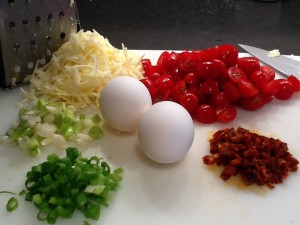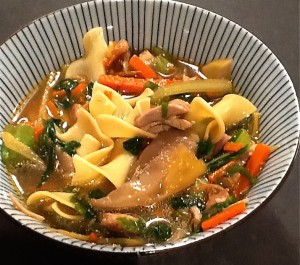There was a little dried Spanish chorizo left over from a project in the test kitchen and I had a craving for spicy eggs a while ago, and chorizo eggs were born. These have become a test kitchen favorite and are perfect for a light supper, brunch or late breakfast. (I’m not a breakfast right away kind of person, I need a few hours before I can figure out what it is I feel like eating by which time I’m usually ravenous and craving something very savory.)

I just have to tell you though, the texture of these eggs poached over the tomatoes is super silky and tender, in short – simply wonderful. I’ve written the recipe as a one hungry person portion. You could slide a third egg in there if you wanted to feed one not so hungry person and one hungry person. To feed more than that or a crowd (or as many people as your skillet will hold eggs), you won’t need to scale the oil up evenly, a tablespoon or two is all that is needed even for a crowd, just enough to release all those wonderful flavors from the chorizo, crisp it up a little bit and give the tomatoes some fat to soften in.

2 teaspoons oil
1/2 oz. chorizo (not fresh chorizo), finely chopped
2 plum tomatoes, chopped (or a about two cups of grape tomatoes or one medium tomato – use whatever you have on hand, if you don’t quite have two cups don’t worry, a little less tomato just makes it a bit more chorizo-ey.)
2 scallions, chopped, white and green parts separated
finely chopped, seeded jalapeno to taste
2 large eggs
grated Cheddar cheese or Monterey Jack or a combination
hot sauce, warm tortillas and cilantro for serving (chopped avocados are nice too)

1. Heat the oil in a small non-stick skillet. Cook the chorizo in the oil over fairly brisk heat
until it begins to sizzle a bit, around 2 or 3 minutes. The oil should turn that nice orangey color from the spices in the chorizo and the chorizo should begin to
brown on the edges a little.
2. Add the tomatoes and the white and pale green parts of the scallions. Cook the tomatoes, stirring now and then, until they soften but not to the point where they begin to dry up, it should be a bit saucy.

3. Slide the skillet off the heat and crack the eggs one at a time onto the tomato mixture. Use the egg to indent the tomato mixture slightly as you open the cracked egg onto it
(alternatively, use the back of a spoon to make a slight indent into which you can crack the egg).
4. Cover the skillet, return it to the heat bring it to a brisk simmer. Allow the eggs to poach until just opaque and still jiggly – about 2 minutes. The two minute mark holds for two eggs or twelve eggs. If you are unsure you can check doneness by giving the white part of one of the eggs a gentle poke with a knife, it should be soft and set not clear and runny.

5. Remove the skillet from the heat, sprinkle the eggs with cheese and re-cover the skillet.Allow the skillet to sit until the cheese melts, about two minutes more. The cheese should melt and the eggs should finish cooking without having to return the skillet to the heat but if you like a lot of cheese (or eggs that are not runny) you may need to return the skillet to
the heat for a few seconds. Just briefly bring it back to a simmer before allowing it to rest while the cheese melts. Be careful, it is easy to over cook the eggs at this point.
Sprinkle with the scallion greens and serve as soon as possible with hot sauce and warm tortillas. Some folks like a little cilantro on top as well. For a crowd, set out your tortillas,
hot sauce and any other fixings, serve the eggs right in the skillet and let people help
themselves. I’ve gotten as many as 12 eggs in a 12-inch skillet.





 1/2 cup corn oil
1/2 cup corn oil



 Trim any excess fat from the chicken thighs. Pat them dry and season lightly with salt and pepper. Heat the oil in a large-ish pot (4 quarts or larger) over medium high to high heat. Cook the thighs until nicely browned and cooked through. (About 10 – 15 minutes.) Set the chicken aside while you proceed with the rest of the soup. While the chicken is cooking, set a pot of water on the stove to boil for the noodles.
Trim any excess fat from the chicken thighs. Pat them dry and season lightly with salt and pepper. Heat the oil in a large-ish pot (4 quarts or larger) over medium high to high heat. Cook the thighs until nicely browned and cooked through. (About 10 – 15 minutes.) Set the chicken aside while you proceed with the rest of the soup. While the chicken is cooking, set a pot of water on the stove to boil for the noodles. stirring until the mushrooms are softened (about 5 minutes,depending upon how large the pieces are.)
stirring until the mushrooms are softened (about 5 minutes,depending upon how large the pieces are.)